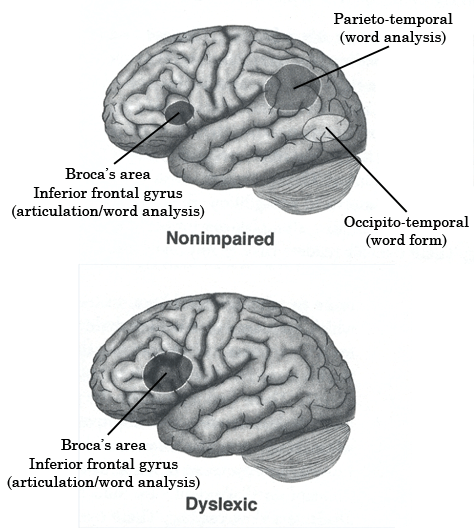Imagine if this article was written like this: Dyslexia is wehn yuor midn gets wodrs mixde pu. The word dyslexia is derived from the Greek “dys” (meaning poor or inadequate) and “lexis” (word or language). Dyslexia is a learning disability characterized by problems in expressive or receptive, oral or written language. It is characterized by extreme difficulty learning and remembering letters, written or spoken words, and individual letter sounds. Extremely poor spelling and illegible handwriting are common symptoms. Problems may emerge in reading, spelling, writing, speaking, or listening. Dyslexia is not a disease; therefore it doesn’t have a cure. Dyslexia describes a different kind of mind, often gifted and productive, that learns differently.
Causes
Dyslexia is not the result of low intelligence. The problem is not behavioral, psychological, motivational, or social. It is not a problem of vision;  people with dyslexia do not “see backward.” Dyslexia results from the differences in the structure and function of the brain. People with dyslexia are unique; each having individual strengths and weaknesses. Many dyslexics are creative and have unusual talent in areas such as art, athletics, architecture, graphics, electronics, mechanics, drama, music, or engineering. Dyslexics often show special talent in areas that require visual, spatial, and motor skills. Their problems in language processing distinguish them as a group. This means that the dyslexic has problems translating language to thought (as listening or reading) or thought to language (as in writing or speaking). Dyslexics sometimes reverse letters and words (b for d, saw for was). In speech, some dyslexics reverse meanings (hot for cold, front seat for back seat) or word sounds (merove for remove). Here is a test to see if you have any signs of dyslexia. Few dyslexics show all the signs of the disorder. Here are some of the most common signs:
people with dyslexia do not “see backward.” Dyslexia results from the differences in the structure and function of the brain. People with dyslexia are unique; each having individual strengths and weaknesses. Many dyslexics are creative and have unusual talent in areas such as art, athletics, architecture, graphics, electronics, mechanics, drama, music, or engineering. Dyslexics often show special talent in areas that require visual, spatial, and motor skills. Their problems in language processing distinguish them as a group. This means that the dyslexic has problems translating language to thought (as listening or reading) or thought to language (as in writing or speaking). Dyslexics sometimes reverse letters and words (b for d, saw for was). In speech, some dyslexics reverse meanings (hot for cold, front seat for back seat) or word sounds (merove for remove). Here is a test to see if you have any signs of dyslexia. Few dyslexics show all the signs of the disorder. Here are some of the most common signs:
- Lack of awareness of sounds in words, sound order, rhymes, or sequence syllables
- Difficulty decoding words – single word identification Difficulty encoding words – spelling
- Poor sequencing of numbers, of letters in words, when read or written, e.g.; b-d; sing – sign; left – felt; soiled – solid; 12-21
- Problems with reading comprehension Difficulty expressing thought in written form
- Delayed spoken language
- Imprecise or incomplete interpretation of language that is heard
- Difficulty in expressing thoughts orally
- Confusion about directions in space or time (right and left, up and down, early and late, yesterday and tomorrow, months and days)
- Confusion about right or left handedness
- Similar problems among relatives
- Difficulty in mathematics – often related to sequencing of steps or directionality or the language of mathematics
Treatment & Coping
There are several ways to discover and successfully cope with a learning disability such as dyslexia. One method is to have the dyslexic person take a visual examination by a behavioral optometrist. Here is how one person learned to cope with dyslexia: A man that was examined had problems in eye tracking. He couldn’t follow a line across a page smoothly, and his eyes were operating independently. Extensive vision  therapy was begun. He came to the offices two and three times a week. No special reading training was suggested. Within a year he was reading at three or more years above his class level. His grades jumped from low scores to the top of the class. He was pleased with himself academically, and no longer found it necessary to walk out of class when he was agitated – in other words, he didn’t get that upset anymore.
therapy was begun. He came to the offices two and three times a week. No special reading training was suggested. Within a year he was reading at three or more years above his class level. His grades jumped from low scores to the top of the class. He was pleased with himself academically, and no longer found it necessary to walk out of class when he was agitated – in other words, he didn’t get that upset anymore.
Dyslexia is easier to prevent than to cure. Individuals with dyslexia need special programs to learn to read, write, and spell. Traditional educational programs are not always effective. Individuals with dyslexia require a structured language program. Dyslexia does not usually go away of its own accord, and it can follow otherwise a bright individual.
Societies can provide referrals for testers, tutors, and schools specializing in dyslexia, as well as information on new technologies, Individualized Education Programs (IEPs), Individuals with Disabilities Education Act (I.D.E.A.) legislation, Americans with Disabilities Act accommodations for college students and adults, and medical research updates. They encourage early intervention, including a multisensory, structured, sequential approach to language acquisition for individuals with dyslexia. They offer professionals and educators information on multisensory structured language approaches to teaching individuals with dyslexia.
